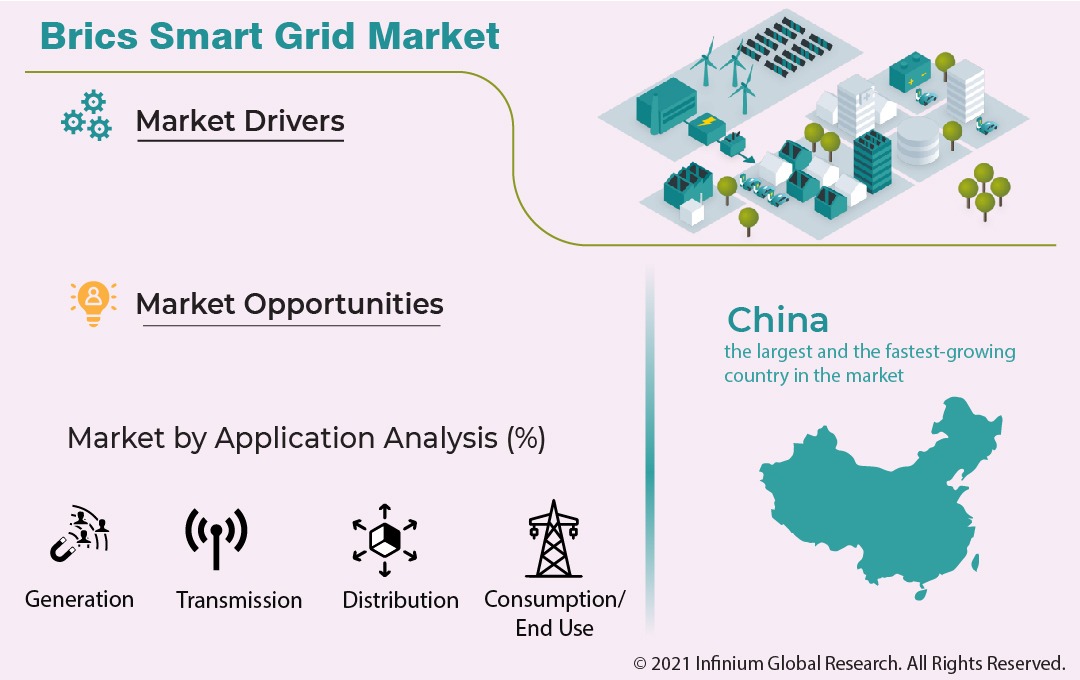BRICS Smart Grid Market (Component - Software, Hardware, and Services; Application - Generation, Transmission, Distribution, and Consumption/end Use): Industry Analysis, Trends, Size, Share and Forecasts to 2027
A recent report published by Infinium Global
Research on BRICS smart grid market provides in-depth analysis of segments and
sub-segments in the BRICS as well as regional smart grid market. The study also
highlights the impact of drivers, restraints, and macro indicators on the BRICS
and regional smart grid market over the short term as well as long term. The
report is a comprehensive presentation of trends, forecast and dollar values of
the BRICS smart grid market. According to the report, the BRICS smart grid
market is projected to grow at a healthy CAGR over the forecast period of
2021-2027.
Market Insight
BRICS countries are under increasing pressure
to limit high energy consumption triggered by outsourcing from developed
nations. The smart grid refers to the electric network containing various
electric components including transmission lines, transformers, substations,
and several other components that help to deliver electricity from the power
plant to the consumer. The smart grid enables real-time monitoring, analysis,
and control of the power system that further helps to improve efficiency,
minimize transmission and distribution loss, and reduce energy consumption and cost.
The benefits offered by the smart grid over
the conventional power supply system are the major factor facilitating the
growth of the smart grids market. The governments across the BRICS countries
are focusing on the modernization of energy grids by adopting smart grid
solutions with the increase in energy demand and aging electricity
infrastructure. Smart grid helps to gain competitive advantage as well as
increases productivity. Energy management software control system is designed
to reduce energy consumption, improve the utilization of the system, increase
reliability, and predict electrical system performance as well as optimize
energy usage to reduce cost. The conventional electricity system may blackout
due to some electricity disturbances that can majorly affect banking,
communications, traffic, and security systems. The smart grid system is able to
handle the electricity conflicts caused by storms, earthquakes, large solar
flares, and terrorist attacks by allowing for automatic rerouting when equipment
fails. In addition, the smart grid technology allows customer-owned power
generators to produce power when it is not available from utilities. The
distributed generation facility provided by the smart grid technology helps
hospitals, traffic lights, police departments, and many other systems to
operate during emergency situations. However, the high installation cost of
smart grids hampers the BRICS smart grid market. Moreover, growing energy
infrastructure and trending smart city projects are projected to create many
opportunities for the BRICS smart grid market in the upcoming years. The virus
that causes coronavirus disease introduced many changes in energy consumption.
While the lockdown measures imposed on millions of people in BRICS countries have
brought business as usual to a standstill, the associated estimated decline in
global energy demand means that carbon dioxide emissions decreased. In BRICS
countries, where offices, factories, bars, restaurants, and theaters remain
closed, energy consumption has fallen which is directly impacted on the BRICS
smart grid market.
Geographically, China is the largest and the
fastest-growing country in the BRICS smart grid market owing to the rapidly
growing technological and infrastructure advancements in the energy sectors.
The increasing adoption of a smart meter in the China and India is likely to
boost the growth of the BRICS smart grid market in these countries. India also
holds a significant market share owing to the presence of energy management
solutions providers with the most comprehensive network management solution,
with features such as monitoring, analysis, control, optimization, planning,
and training tools.
Segment Covered
The report on BRICS smart grid market covers
segments such as component, and application. On the basis of component, the
sub-markets include software, hardware, and services. On the basis of
application, the sub-markets include generation, transmission, distribution,
and consumption/end use.

Companies Profiled:
The report provides profiles of the companies
in the market such as Siemens, Schneider Electric, Sensus, Tech Mahindra,
Wipro, Esyasoft Technologies, Silver Spring Networks, and Other companies.
Report Highlights:
The report provides deep insights into the
demand forecasts, market trends, and micro and macro indicators. In addition,
this report provides insights into the factors that are driving and restraining
the growth in this market. Moreover, The IGR-Growth Matrix analysis given in
the report brings an insight into the investment areas that existing or new
market players can consider. The report provides insights into the market using
analytical tools such as Porter's five forces analysis and DRO analysis of
BRICS smart grid market. Moreover, the study highlights current market trends
and provides forecast from 2021-2027. We also have highlighted future trends in
the market that will affect the demand during the forecast period. Moreover,
the competitive analysis given in each regional market brings an insight into
the market share of the leading players.
